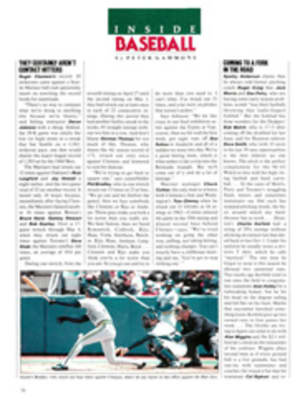
WHY DOES A SWIMMER CHALLENGE THE CHANNEL? TO GET TO THE OTHER SIDE
Question: Who was the first person to swim the English Channel? No, it wasn't Gertrude Ederle—she was the first woman, and she did it in 1926. The first man was Captain Matthew Webb of Great Britain. He did it in 1875, and it took him 21 hours and 45 minutes.
Since then, hundreds of hearty souls have swum the Channel (477 crossings so far), and hundreds more flock each year to the White Cliffs of Dover to join the anonymous, not-so-select group of Channel swimmers.
"More people than ever want to swim the Channel," says Raymond Scott, chairman of the Channel Swimming Association, founded in 1927. "It's lost none of its glamour, and it's certainly not any easier. It's still a nasty bit of water."
Notoriously so. The water is cold, no more than 62° in August, the best month for Channel swimming. The wind is always chilly, jellyfish are common, there can be rain, fog and even lightning at a moment's notice. Another major detail is the tidal clock. If a swimmer takes too long on a food break and isn't in the right place when the tide changes, he can be swept downshore extra miles, which translates into extra hours in the water. Unpredictable, choppy seas frequently halt the English-French ferry service on the 20-to 30-mile passage. In one sense it's harder today than ever: The Channel is one of the world's busiest shipping lanes; dodging vessels and maneuvering around oil slicks and pollution are new liabilities. The many hazards, says Scott, have helped keep the Channel popular well into an era of 100-mile marathon swims. The success rate is roughly one in four.
Audrey Scott, the C.S.A.'s honorary secretary and statistician, and Raymond, her husband, supervise the human traffic and keep the official results from their home office in Folkestone. Many of the seaside towns have hotels willing to make special preparations for swimmers, and the C.S.A. has access to pilots for hire, observers and the coast guard. The cost of an attempt is around $2,300.
"Preparation is all-essential, apart from physical readiness," says Audrey. "There are a lot of details to attend to—hiring a boat and a pilot, scheduling a witness, first-aid medications, specially prepared food, drinking water, towels and a place to recuperate when you reach the shore. The association tries to see that no one is undone by forgotten details."
The Channel's most frequent customers, says Raymond, are Americans, and many of them are intent on setting new records. For example, Penny Lee Dean, then living in Santa Clara, Calif., was not satisfied merely to be attempting the 280th crossing when she dived in at Shakespeare Beach back in 1978. She harbored the hope of becoming the fastest woman.
"When I was 10," says Dean, "I tried to swim the Golden Gate and didn't make it; it was a failure that really haunted me. I decided I would not only swim the English Channel but try to set the world record. It was a dream—a project for 16 years."
When Dean emerged at Cap Gris Nez, France at seven hours and 40 minutes, she was told she had become the fastest ever across the Channel, man or woman. Her record still holds.
"It was a matter of determination," says Dean. "I swam as if it was my last and only chance because, well, that's what it was."
Dean was born with a defective artery in her left arm, and doctors told her after her swim that she could never accomplish such a feat again. In fact, today, though she coaches women's swimming and water polo at Pomona College in Claremont, Calif., a 100-yard swim around the pool is next to impossible for her.
Others have tried to swim to distinction, to scale the hierarchy of Channel crossings, and there are numerous categories of achievement. The titles of King and Queen of the Channel belong to the most frequent crossers. At 31 crossings, far and away the most, the King is Michael Read of Great Britain, who has made as many as six crossings in a year to bolster his tally. The Queen is Cynthia Nicholas of Scarborough, Ont., with 19. Ashby Harper (SI, June 6, 1983) of Albuquerque is the senior swimmer at 65, and Marcus Hooper of London, who was 12 in 1979, holds the title for youngest.
In 1961 Antonio Abertondo of Argentina had an idea that still separates the men and women from the boys and girls: the two-way swim. In the course of 43 hours and 10 minutes he swam from England to France, jumped back in, and emerged triumphantly in St. Margaret's Bay, Dover. Ted Erikson of Chicago is one of the 15 people who have since accomplished the two-way. When he did it, in 1965, he established a world record of 30 hours and 3 minutes.
"It was a bit, I suspect, like having a baby," says Erikson. "There were some terrible moments along the way, but once it was over I couldn't have been prouder. Never thought of quitting once, though. Then my son had to go and one-up the old man...."
In 1975 Jon Erikson also crossed the Channel both ways, bettering his father's world record—by three minutes. The two-way record is now held by Philip Rush of New Zealand, who made it in 17 hours 56 minutes.
"Yes, I was hoping for the world record," says Jon. "I wanted to make my mark in marathon swimming. It's getting pretty hard to do that these days."
Having swum on the marathon circuit for 10 years, young Erikson decided to establish another record not likely to fall easily—the three-way swim.
"The first two times I tried it, I gave out," he says. "Once I had crossed twice, and was three-quarters through my third...it's still frustrating for me to think about that now. But my third attempt did the trick."
On Aug. 11 and 12, 1981, Erikson swam from Dover to France, swam back to England, turned around again and arrived in France, having spent more than a day and a half in the water: 38 hours and 27 minutes.
"Of course, I know someone will someday beat the time," says Erikson, "but I'll have made my mark. After doing something like that, you start thinking almost anything is possible."
Relay teams (with six members each) have cut the Channel down to size as well, and 120 teams have performed the feat. In 1980 a British swimming club decided to silence the competition by completing an England-to-Belgium swim—60 miles of waters more rotten than the Channel's—in 26 hours, 40 minutes, concluding near De Panne, Belgium.
"I guess that there are people who consider one time across as no big deal," says Stephen Fossett, whose France-to-England crossing (supposedly the easy way) in unexpected bad weather took him 22 hours and 15 minutes last year. "But we're all there to test what our limits are, to measure ourselves against the world's most famous endurance event. Everybody knows what it means to be able to say, 'Hey, I swam the English Channel.' "
ILLUSTRATION
JOAN HALL
William Barnhardt is a free-lance writer who is living in Oxford, England.

